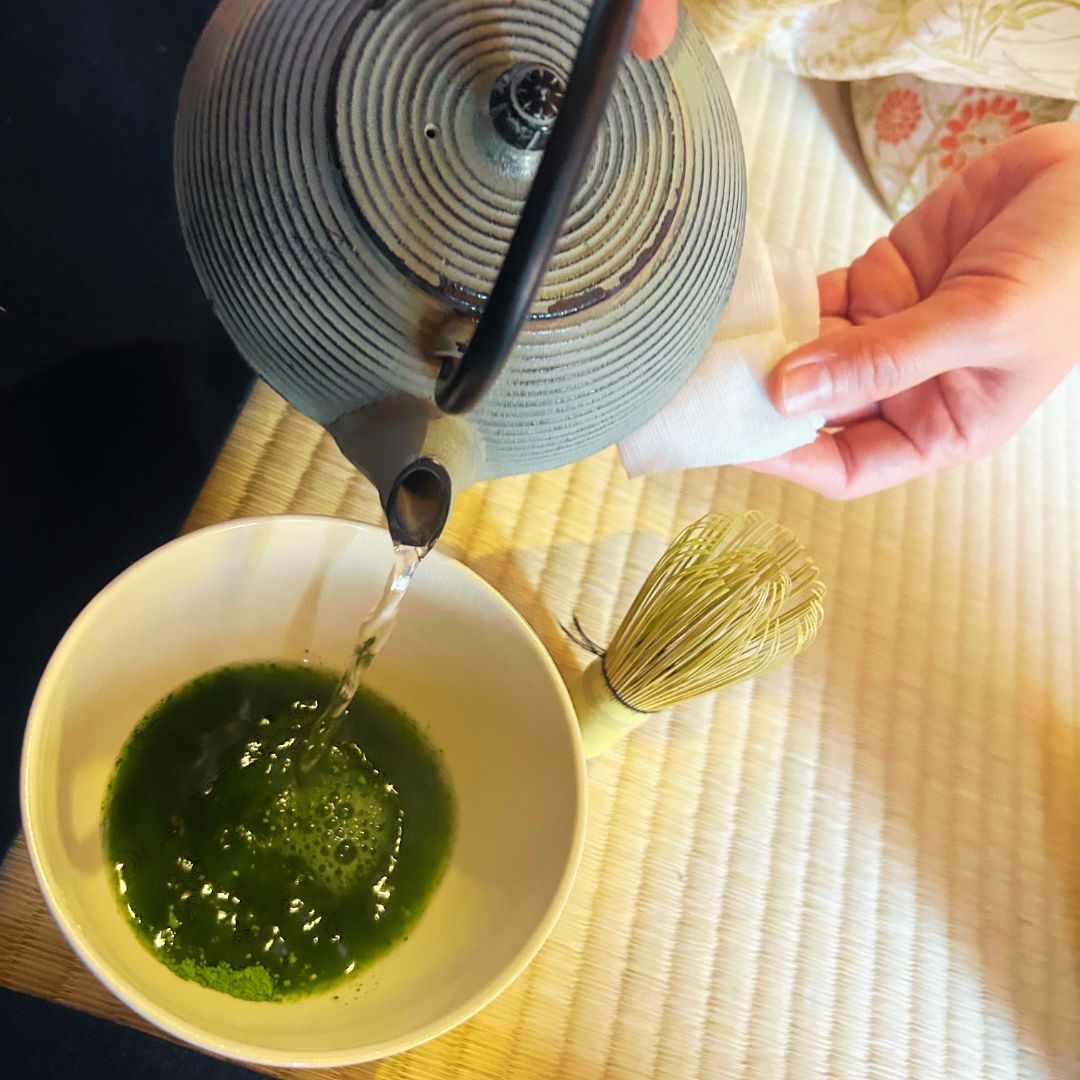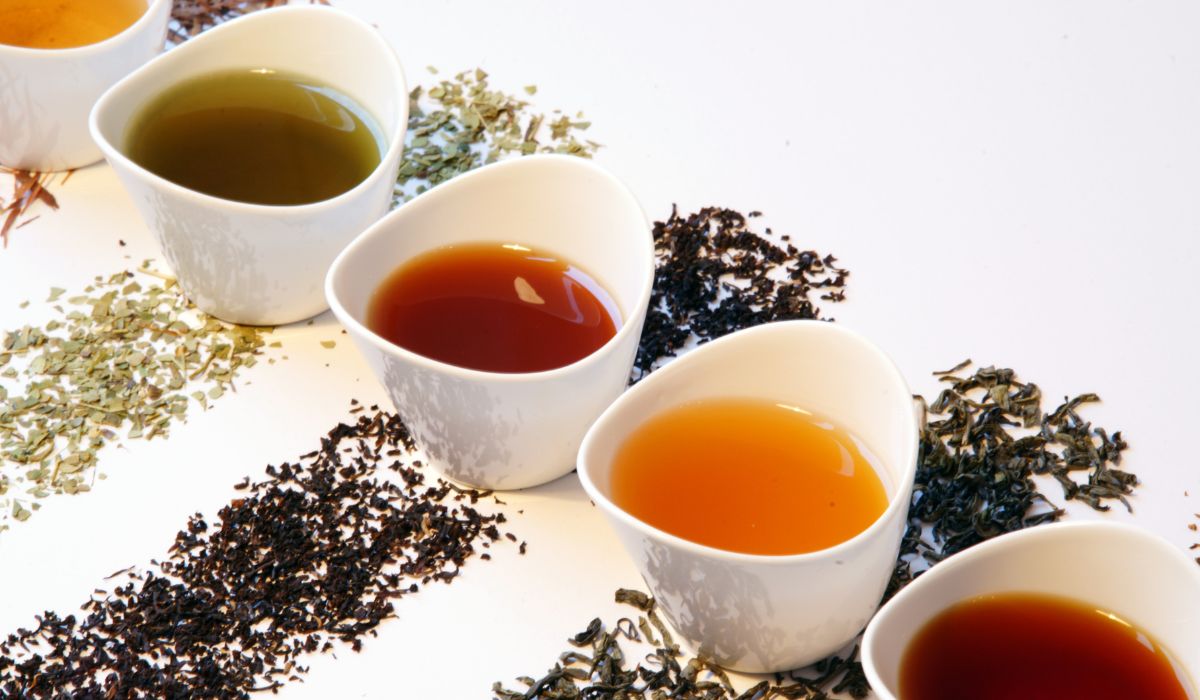
أوجي ماتشا
بواسطة بريميوم هيلث اليابان


في عالم من الخلطات، نحن نتميز عن غيرنا. جرب نقاء الماتشا أحادي المنشأ، ماتشا أحادي الصنف
شاي أوجي ماتشا العضوي وإكسسوارات الشاي
المنتجات حسب الفئة
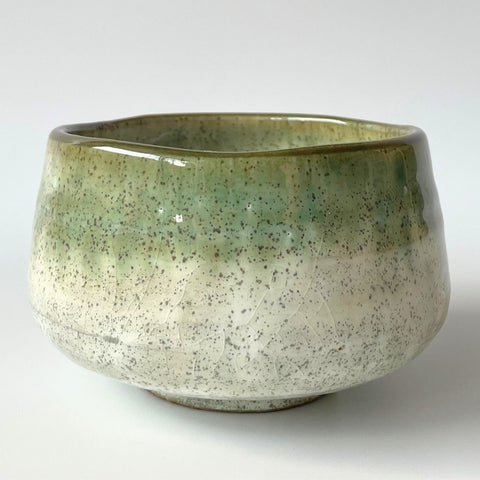
صحن ماتشا أوميرالد أوازيس

وعاء ماتشا زهرة الكرز بالكرز

صحن ماتشا سوثينغ ريتريت
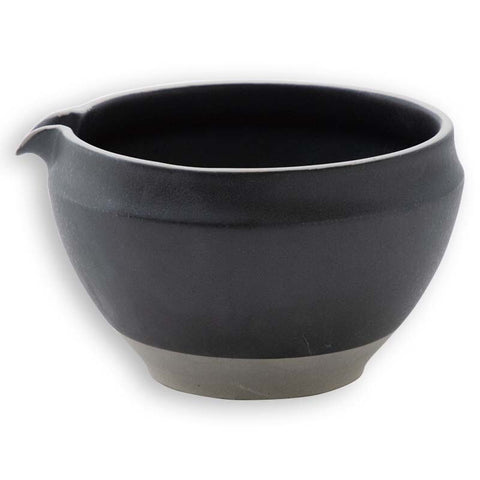
وعاء ماتشا ساكورا ماتشا مطلي يدوياً
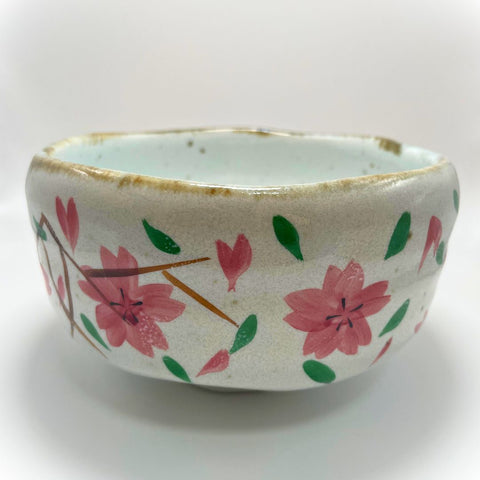
وعاء ماتشا ساكورا ماتشا مطلي يدوياً
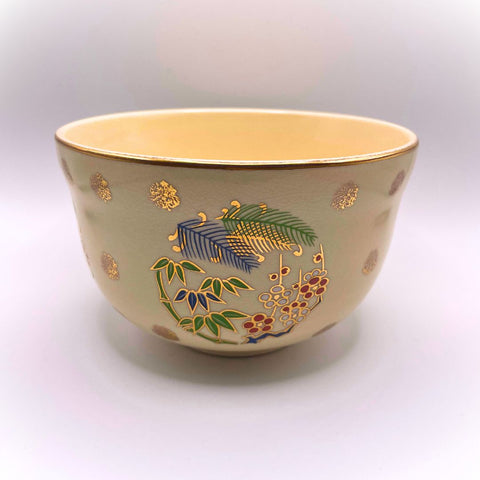
وعاء ماتشا ماتشا مستوحى من شوتشيكوباي المستوحى من نينسي

خفاقة خيزران تاكاياما تشاسن الممتازة المصنوعة يدوياً

خفاقة ماتشا ماتشا 100 شوكة مصنوعة يدوياً

طقم خفقت الماتشا النهائي - أدوات شاي الخيزران التقليدية

مغرفة تشاشاكو بامبو تشاشاكو ممتازة مصنوعة يدوياً
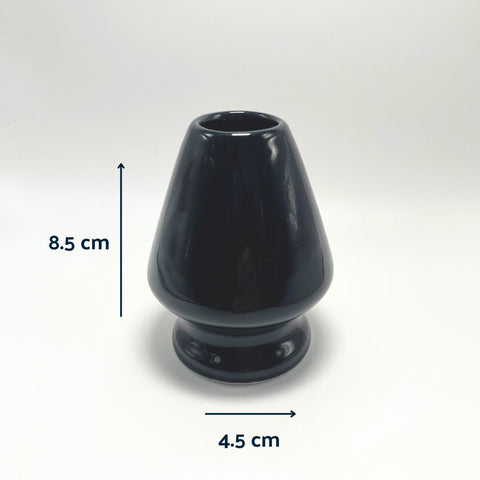
حامل خفاقة ماتشا سيراميك أسود اللون مصنوع يدوياً (صنع في اليابان)
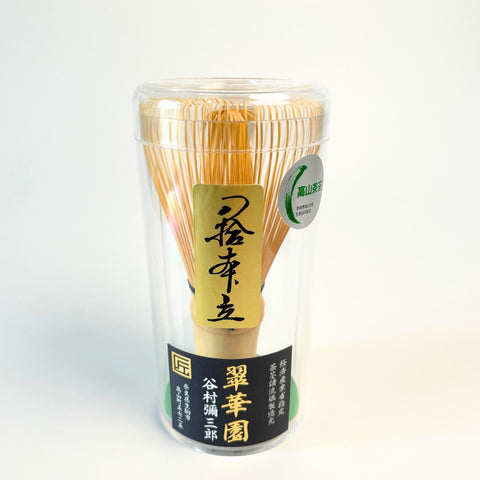
خفاقة خيزران تاكاياما تشاسن الممتازة المصنوعة يدوياً
عضوي معتمد
الزراعة في اليابان

ماتشا أوجي ماتشا معتمد

الاسم التجاري: 株式会社プレミアムヘルスジャパン (Premium Health Japan Co. Ltd.)
أفضل مسحوق ماتشا من اليابان
مرحباً بكم في بريميوم هيلث جابان، المتخصصون في ماتشا أوجي ماتشا الأصلي. نربط مزارع الشاي التقليدية بالعملاء الدوليين من خلال فريق عمل ثنائي اللغة، ونقدم لكم ماتشا أوجي ماتشا الحصرية ومستلزمات الشاي. سواء كنت تتطلع إلى الاستمتاع بشاي ماتشا عالي الجودة أو إطلاق علامتك التجارية الخاصة، فإننا نوفر لك وصولاً خاصاً إلى أفضل مزارع الشاي في اليابان.
WHAT OUR CUSTOMERS SAY ABOUT OUR MATCHA
OM(atcha)G!!!
This is the best matcha I have ever tasted. Hot or cold, it has a strong smooth flavour, creamy consistency, the most beautiful shade of vibrant green, and gives me plenty of jitter-free giddy up. I can't drink whatever stuff I was using before I discovered this brand. They do matcha to perfection. Love it. Mean it. Drink it.
Great!
Refined, smooth and great quality! Best matcha powder I’ve had.
Umami!!
This is a delicious matcha
Excellence
Excellence in a world of lower standards; authenticity in a world of duplicity; consistency in an inconsistent world!
Excellent quality!
An excellent quality Matcha with fast shipping and great customer service.
Wonderful
This matcha is vibrant and smooth with a sweet, earthy aroma. It is truly wonderful.
Beautiful
One of the best Matcha I've ever tried. Really fresh and beautiful.
Amazing!
Great! Loving this matcha. Bought about 6 so far and won’t go anywhere else. The quality and taste is amazing!!!
Rich and flavorful!
The aroma of cherry greeted me as I was preparing to make a bowl of matcha. It was slightly and pleasantly more pronounced when I poured a little hot water over the sifted powder to create a paste. When I poured in the remaining water and whisked, I also caught a slight whiff of chocolate. I prepare it as usucha, more to be able to spend extra time (and more sips!) enjoying the matcha than anything else. It is wonderful — full of umami, complex flavors and a rich mouth feel!
ما هو أوجي ماتشا؟
شاي أوجي ماتشا هو شاي أخضر ممتاز يُزرع ويُعالج حصرياً في كيوتو، اليابان. يشتهر بنكهته الغنية ولونه النابض بالحياة وطرق إنتاجه عالية الجودة.
تم اعتماد أوجي ماتشا من قبل مكتب براءات الاختراع الياباني وهو معتمد من مكتب براءات الاختراع الياباني ويلتزم بمعايير الزراعة والمعالجة الصارمة. تأتي نكهته الفريدة من المناخ وظروف التربة في كيوتو.
تتم معالجة أوجي ماتشا باستخدام الطرق التقليدية التي تساعد في الحفاظ على مذاقها الغني ولونها النابض بالحياة وجودتها الممتازة.
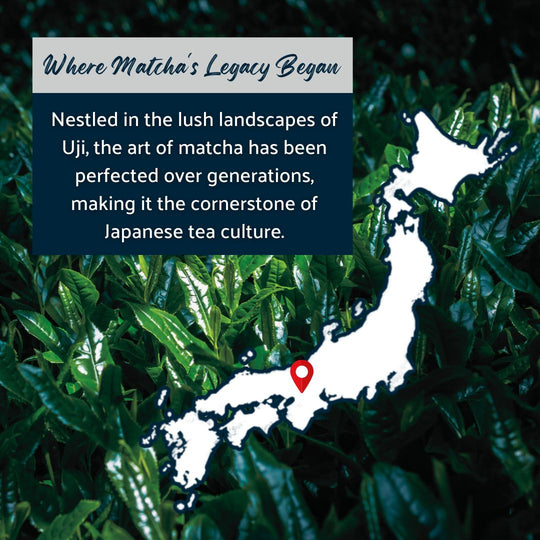
كيفية تحضير شاي الماتشا المثالي
ما عليك سوى إضافة كمية صغيرة من الماء بدرجة حرارة الغرفة إلى مسحوق الماتشا وعمل عجينة.
ثم أضف الماء الساخن، ولكن تأكد من عدم غليانه. يجب أن تكون درجة حرارته من 75 إلى 80 درجة مئوية. إذا كانت أكثر سخونة فستجعل طعم الماتشا مرًا.
اخفقي على شكل حرف "W" و"M" بمضرب الخيزران حتى يصبح رغويًا. يتطلب الأمر التدريب، لذا لا تشعر بخيبة الأمل إذا لم يكن مثاليًا في محاولتك الأولى!
عن الشركة
تأسست شركة بريميوم هيلث اليابان على يد لوك، وهو مدرب ملاكمة أسترالي سابق وخبير لياقة بدنية يعيش الآن في اليابان. وقد قاده سعيه لفهم الفوائد الصحية للشاي الأخضر خلال معركة والدته الراحلة مع مرض السرطان إلى ماتشا.
يتم تنسيق الماتشا لدينا من خلال نهج لوك العملي من المزرعة إلى العبوة، مما يضمن نقاوة وجودة لا مثيل لها. إن علامتنا التجارية هي التزام بالحياة الصحية الأصيلة التي ترتكز على التراث الغني للماتشا.
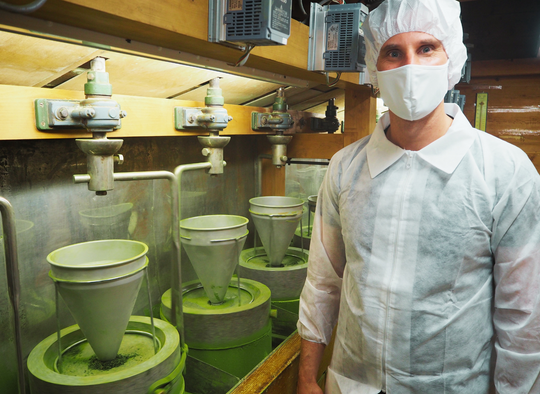
مؤسسنا - لوقا
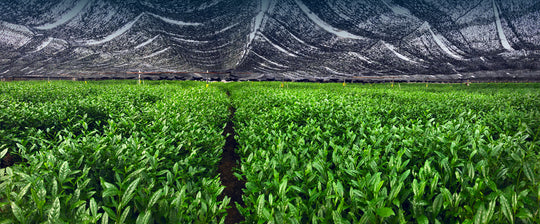
إحدى مزارع الشاي في كيوتو قبل الحصاد
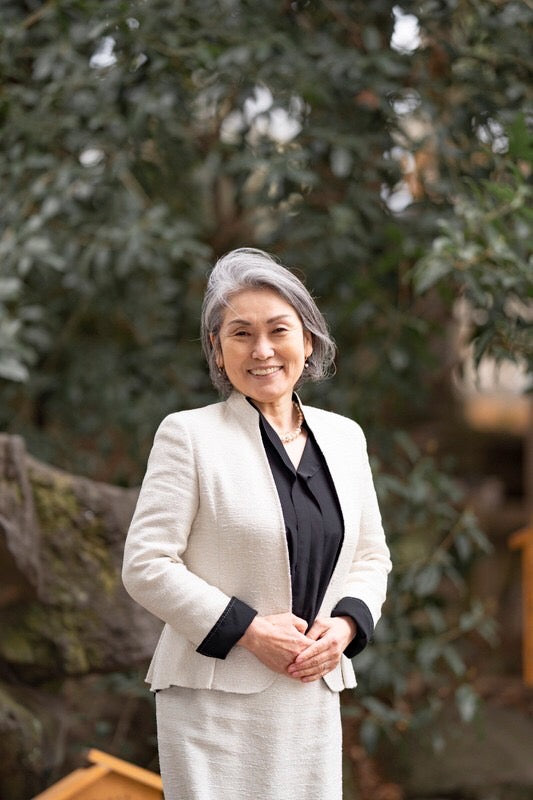
سيد الشاي لدينا - كيميكو
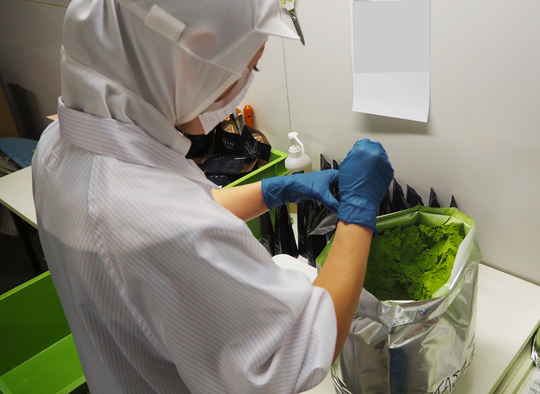
يتم وزن الماتشا الخاصة بنا وتعبئتها بعناية
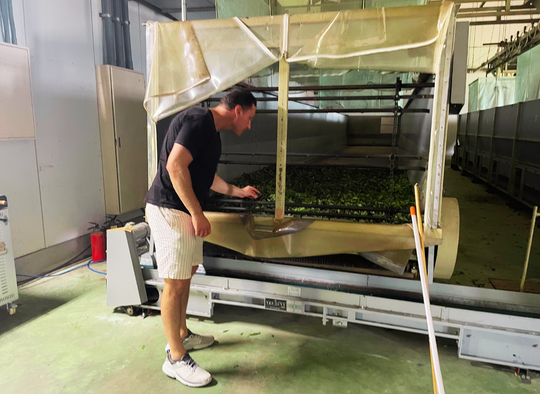
نجري عمليات تفتيش منتظمة على المنشآت
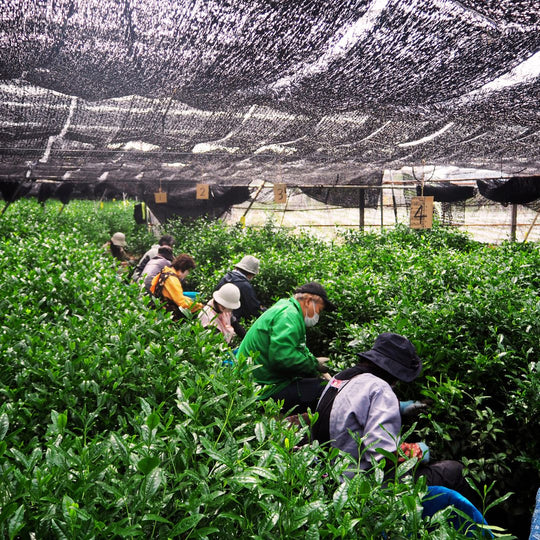
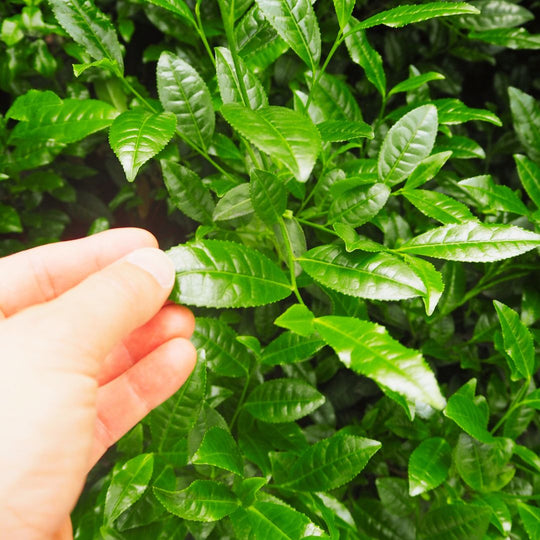
أوراق ماتشا حصاد الربيع الأول ماتشا
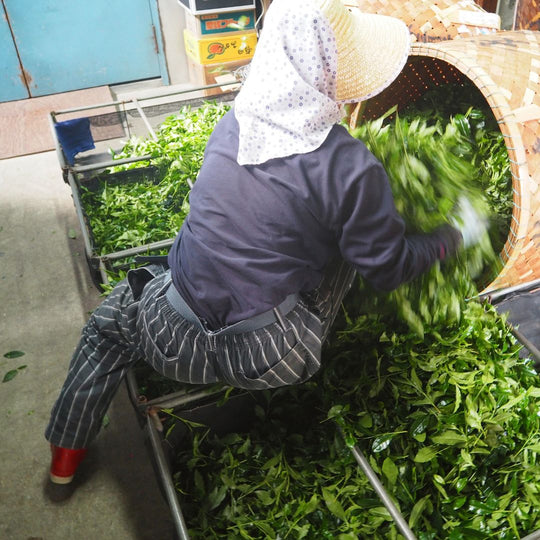
يتم غربلة أوراق الماتشا لفحص جودتها قبل معالجتها
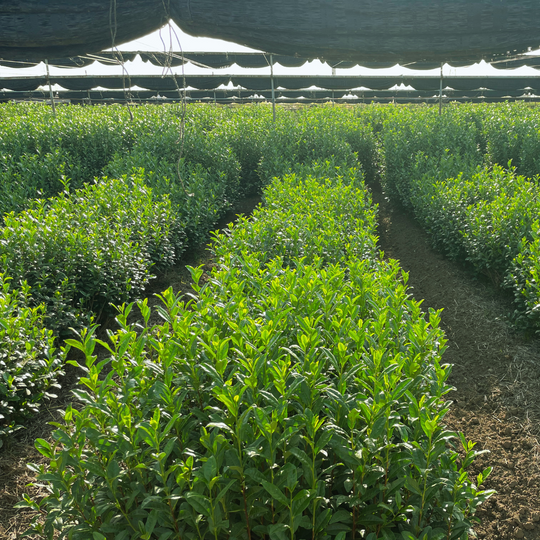
نباتات شاي الماتشا خارج موسم الحصاد في مدينة أوجي

مؤسسنا - لوقا

إحدى مزارع الشاي في كيوتو قبل الحصاد

سيد الشاي لدينا - كيميكو

يتم وزن الماتشا الخاصة بنا وتعبئتها بعناية

نجري عمليات تفتيش منتظمة على المنشآت


أوراق ماتشا حصاد الربيع الأول ماتشا

يتم غربلة أوراق الماتشا لفحص جودتها قبل معالجتها

نباتات شاي الماتشا خارج موسم الحصاد في مدينة أوجي
انضم إلى مجتمع أوجي ماتشا
الأسئلة الشائعة
شاي ماتشا الأخضر غني بمضادات الأكسدة، وخاصة الكاتيكين، والتي قد تساعد في مكافحة تلف الخلايا والالتهابات. لشرب الماتشا أيضًا تأثير في أن يعزز الأيض والطاقة، ويعزز المزاج والتركيز، ويدعم صحة القلب والأوعية الدموية.
ماتشا متجذرة بعمق في الثقافة والتقاليد اليابانية. بالإضافة إلى فوائدها الصحية، فإنها تحمل أهمية احتفالية في اليابان. يحظى أوجي ماتشا، وهو قسم عالي الجودة من منطقة أوجي، بتقدير خاص وساهم في شعبيته على نطاق واسع.
نعم، من الآمن عمومًا تناول الماتشا يوميًا. ومع ذلك، نظرًا لمحتواه من الكافيين، فإن الاعتدال هو المفتاح. يمكن أن يضمن اختيار الماتشا العضوية عددًا أقل من الملوثات وطعمًا أنقى.
في حين أصبحت ماتشا مرادفة للثقافة اليابانية، تم تقديم مفهوم الشاي المجفف لأول مرة إلى اليابان من الصين خلال القرن التاسع. ومع ذلك، قامت اليابان بتحسين طرق الزراعة والتحضير وتعميمها، مما جعل شاي ماتشا الأخضر تمثيلًا مبدعًا للأمة.
يحتوي مسحوق ماتشا على مركبات، خاصة إيبيجالوكاتشين جالات (EGCG)، التي يمكن أن تعزز الأيض وأكسدة الدهون. قد يدعم شرب شاي ماتشا الأخضر جهود إنقاص الوزن، بما في ذلك تقليل دهون البطن. إقرانه بنظام غذائي متوازن وممارسة التمارين الرياضية بانتظام يعزز فعاليته.
Your 2024 Guide to the Best Loose Leaf Green Teas
Discover the best organic loose leaf green teas of 2024 with our curated guide. Experience the rich flavors, health benefits, and cultural significance of carefully selected teas. Trust our guide...
Introduction to the Best Loose Leaf Green Tea
When it comes to enjoying a cup of tea, the quality of the leaf matters as much as the ritual of brewing it. Among the scores of tea varieties, green tea holds a special place for its delicate flavors, health benefits, and the artistry behind its production. This guide will take you through the world of best loose leaf green tea, exploring not just the flavors but the culture, health benefits, and the nuances that make each leaf unique.
💡Did you know that green tea has been consumed for thousands of years and was originally used as a medicinal drink in ancient China?
Main Types of Tea (Overview)
Tea can be broadly categorized into several types based on the processing of the leaves of the Camellia sinensis plant. While black tea, oolong tea, and white tea have unique charm and benefits, green tea and herbal tea are often celebrated for their health-promoting properties.
Green Tea: Known for its fresh, delicate flavor, green tea undergoes minimal oxidation during processing. This preserves its green color and antioxidant-rich profile, making it a favorite among tea enthusiasts.
Black Tea: More oxidized than green tea, black tea offers a robust flavor and higher caffeine content. It's enjoyed hot and as iced tea, making it versatile for any season.
Oolong Tea: Oolong tea is partially oxidized, offering a complexity of flavor that falls somewhere between green and black tea. Its unique processing results in diverse flavors, from sweet and floral to rich and toasty.
White Tea: The least processed of all teas, white tea is prized for its subtlety, natural sweetness, and elegance. Its gentle flavors make it a sophisticated choice for tea lovers.
Herbal Tea: Though not made from the Camellia sinensis plant, herbal teas (like yerba mate and Moroccan mint) offer a caffeine-free alternative with various health benefits.
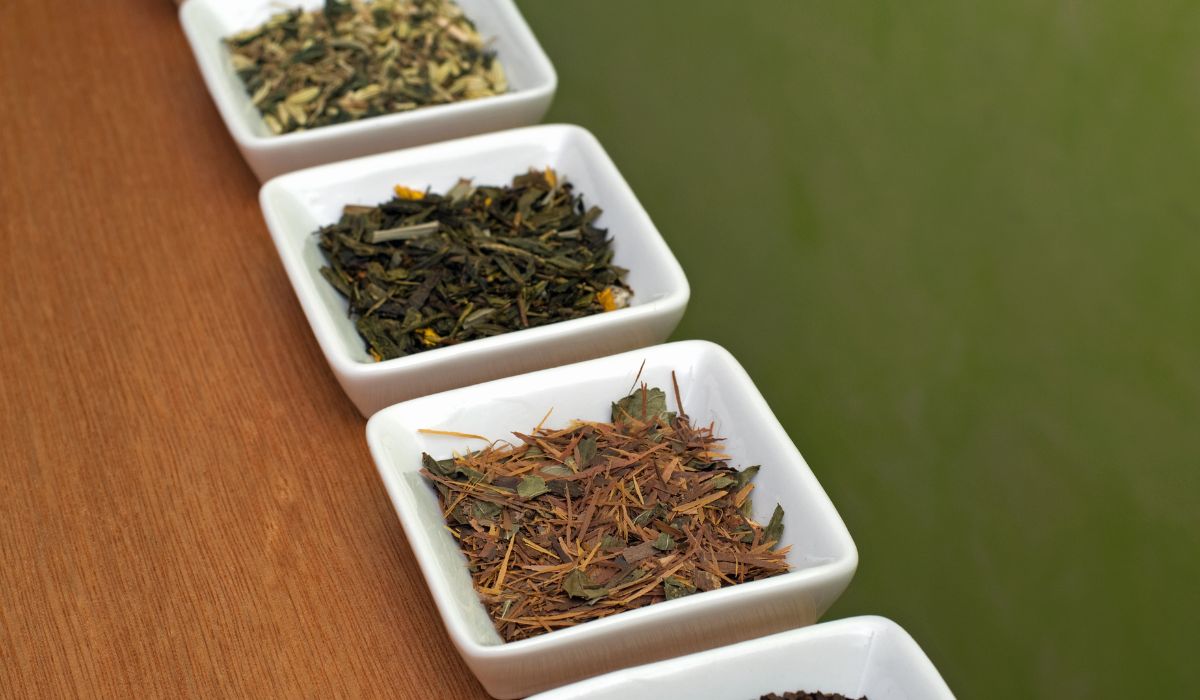
💡Oolong tea's unique flavor results from a special process that involves sun drying and oxidation before curling and twisting the leaves.
The World of Green Tea
The world of green tea is vast, with each variety offering a unique taste profile and set of benefits. From the grassy, sweet notes of Sencha to the nutty depths of Dragon Well tea, green tea varieties are as diverse as the regions they come from.
-
Japanese Green Teas: Japan is renowned for its green teas, with Sencha being the most popular. However, for those seeking the pinnacle of flavor and quality, Gyokuro stands out. Gyokuro is shaded before harvesting, which increases its chlorophyll content and gives it a rich, umami flavor.
-
Chinese Green Teas: China produces a wide range of green teas, including Chun Mee, known for its plum-like sweetness and smooth finish. Dragon Well (Longjing) tea, with its distinctive flat leaves and jade color, offers a mellow, sweet flavor that is highly sought after.
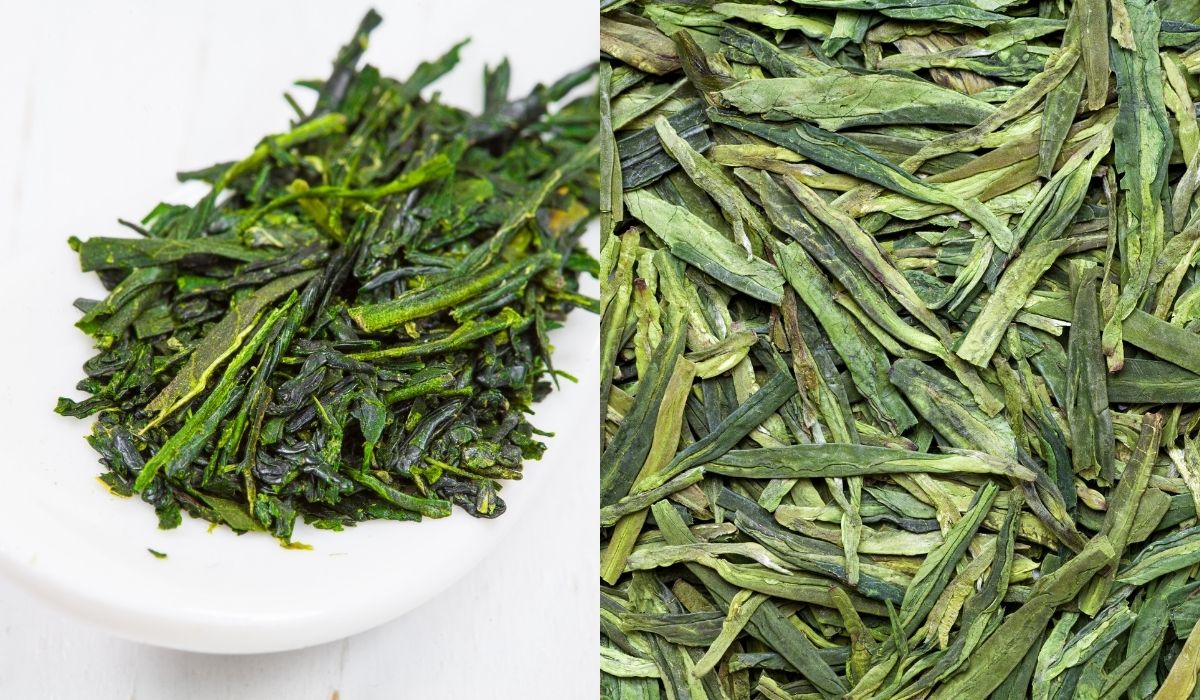
Organic Green Tea: Opting for organic tea means choosing leaves grown without industrial chemicals, ensuring a pure, natural cup. Organic green tea supports a healthy lifestyle and promotes sustainable farming practices.
Premium Loose Leaf Green Teas: The term "premium" is often associated with handpicked teas during the optimal harvest season, ensuring the highest quality and flavor. These teas, including rare and single-origin varieties, offer a full-bodied cup that is both a luxury and a sensory experience.
💡Gyokuro tea is shaded for about three weeks before harvesting, contributing to its unique flavor and higher caffeine content than other green teas.
Health Benefits of Green Tea
Green tea is not just a beverage; it's a rich source of antioxidants and compounds that profoundly affect your health. Here's how incorporating green tea into your daily routine can benefit you:
- Weight Loss: Green tea has been shown to boost metabolic rate and increase fat burning in the short term, making it a valuable ally in weight management.
- Immune System Boost: The antioxidants in green tea, particularly vitamin C and ascorbic acid, can help strengthen your immune system, making you better equipped to fight illnesses.
- Brain Function: Regular consumption of green tea may enhance brain function, improving memory, cognitive performance, and even mood.
- Blood Sugar Regulation: Green tea can help regulate glucose levels, reducing the risk of insulin spikes and diabetes.
- Good Health and Healthy Lifestyle: Beyond these specific benefits, green tea supports a healthy lifestyle, contributing to heart health, reducing the risk of cancer, and promoting longevity.
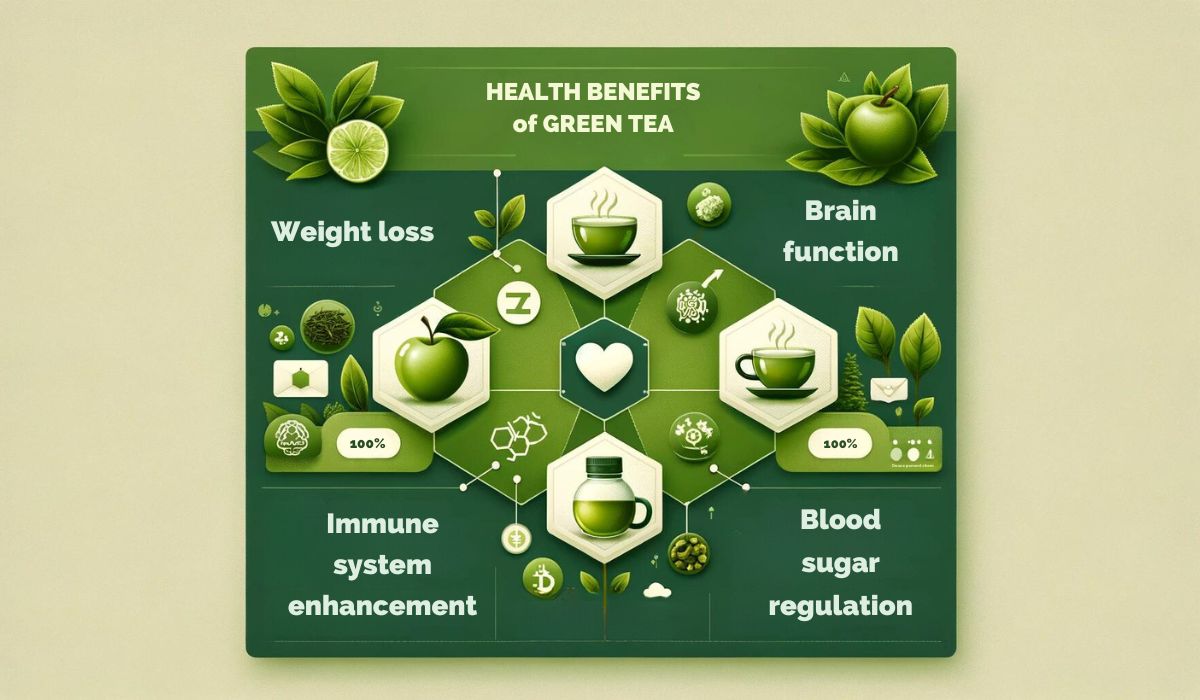
💡Did you know that green tea contains a catechin called EGCG (Epigallocatechin Gallate), known for its cancer-fighting properties?
Brewing the Perfect Cup
The art of brewing green tea is as important as the leaf itself. Here's how to ensure you get the most out of your loose leaf green tea:
- Loose Leaf vs. Tea Bags: Opting for loose leaf tea over standard tea bags can significantly enhance your tea-drinking experience. Loose leaves allow for a fuller expansion during steeping, resulting in a more complex and nuanced flavor.
- Water Temperature and Brewing Time: The ideal water temperature for green tea is between 150°F and 180°F. Boiling water can scorch the leaves, leading to a bitter taste. Steeping time should be between 2 to 3 minutes for the perfect balance of flavor.
- Tea Accessories: A French press or a dedicated tea steep allows for better water circulation around the leaves, extracting maximum flavor. Water quality can also impact the taste, so filtered or spring water is recommended.
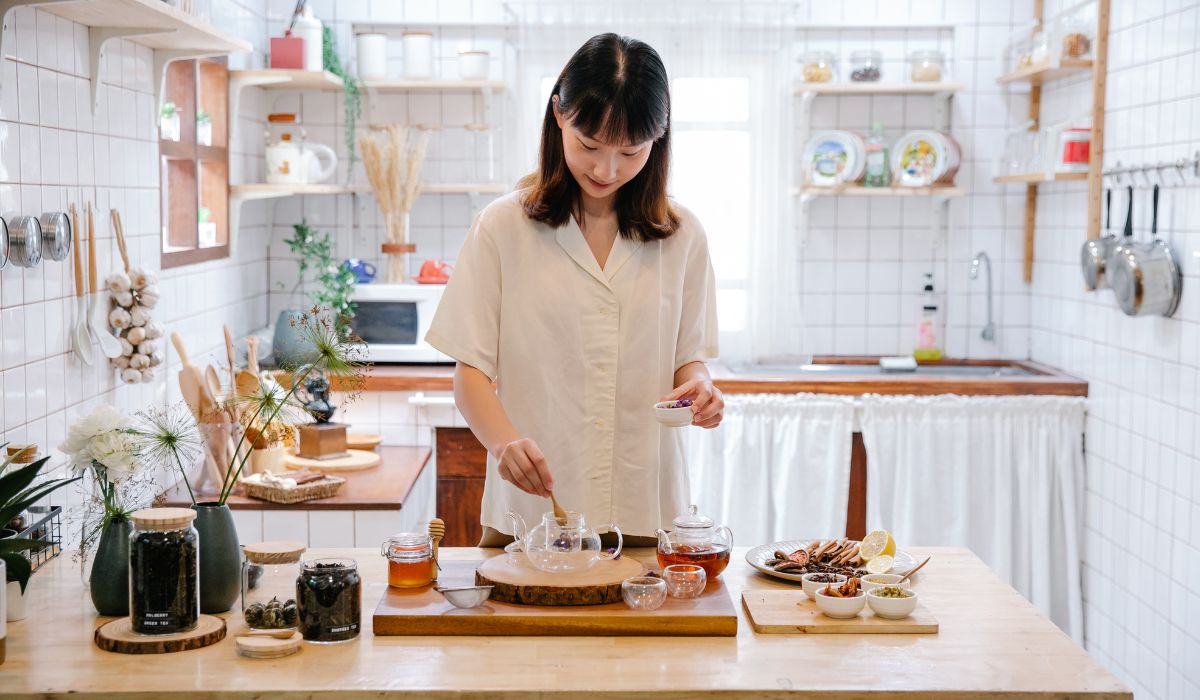
💡The term "steeping" is the process of soaking tea leaves in water to extract their flavors and nutrients, a crucial step in brewing tea.
Tea Culture and Consumption
Tea is more than a drink; it's a cultural experience that varies greatly from one region to another. Here's a glimpse into the tea culture and how it shapes our consumption:
- Tea Enthusiasts and Tea Lovers: For many, tea is a passion. Communities and forums dedicated to tea allow enthusiasts to share their love for rare teas, brewing techniques, and the latest tea accessories.
- Tea-Drinking Experience: The experience of drinking tea can be deeply personal. Some prefer the soothing warmth of hot teas, while others enjoy the refreshing briskness of iced tea. The time of day, the mood, and even the weather can influence one's choice.
- Tea Gifts and Samplers: Tea makes for a thoughtful gift, offering a taste of different cultures and flavors. Tea samplers are especially popular during the holiday season, providing a curated experience of premium and rare teas.
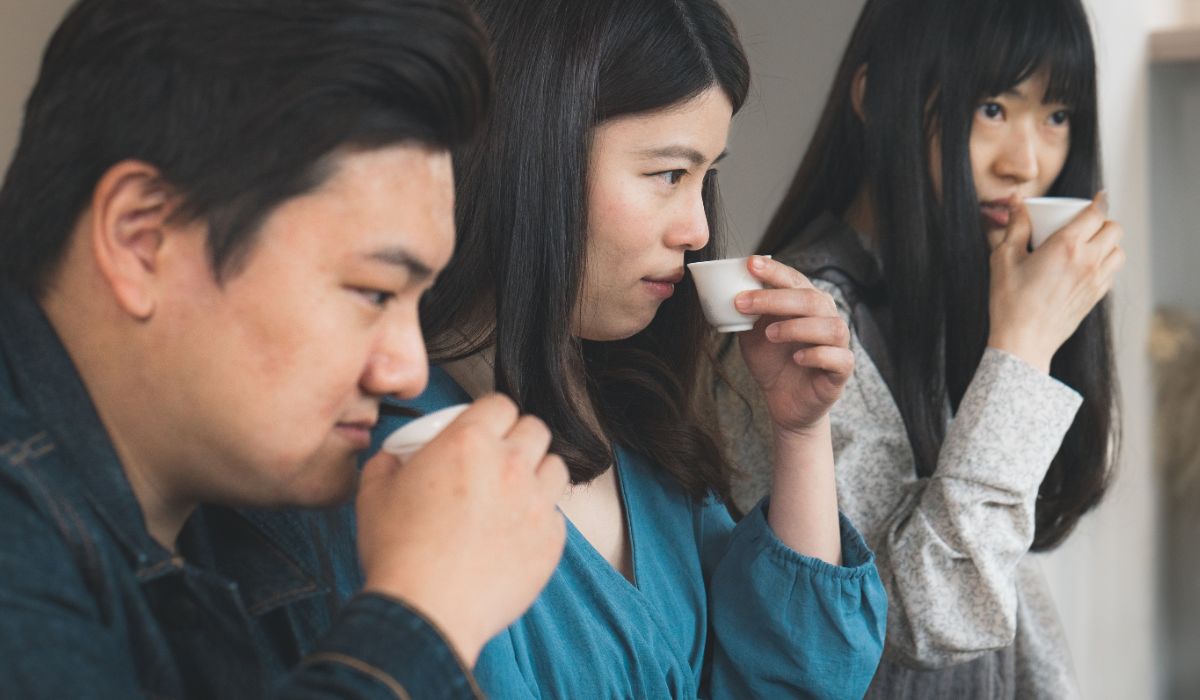
💡In Japan, the traditional tea ceremony, known as Chanoyu, or Sado, is a choreographed ritual of preparing and serving Japanese green tea, specifically matcha, focusing on aesthetics and harmony.
Purchasing and Sustainability
When buying the best loose leaf green tea, knowing where and how your tea is sourced can make all the difference in quality and impact.
-
Fair Trade and Organic Certifications: Look for certified organic and fair trade teas. These labels ensure your tea is grown without harmful pesticides and chemicals and guarantee that the farmers and workers involved are treated and compensated fairly. This commitment to ethical practices contributes to a healthier planet and a more sustainable tea industry.
-
Free Shipping and Customer Ratings: Many reputable tea suppliers offer free shipping on their products, making exploring a diverse inventory of loose teas easier and more affordable. Additionally, paying attention to customer ratings and reviews can guide you toward the best teas, as rated by fellow tea lovers. This feedback can be invaluable in finding teas with exceptional quality and flavor.
-
Diverse Inventory of Loose Teas: A good tea supplier will offer a wide range of teas, from classic favorites to rare and unique varieties. This diversity allows tea enthusiasts to explore new flavors and find teas that suit their preferences. Whether you're looking for the grassy notes of a Sencha, the sweet aroma of a Dragon Well, or the rich umami of Gyokuro, a diverse inventory ensures you'll find the perfect tea for any occasion.
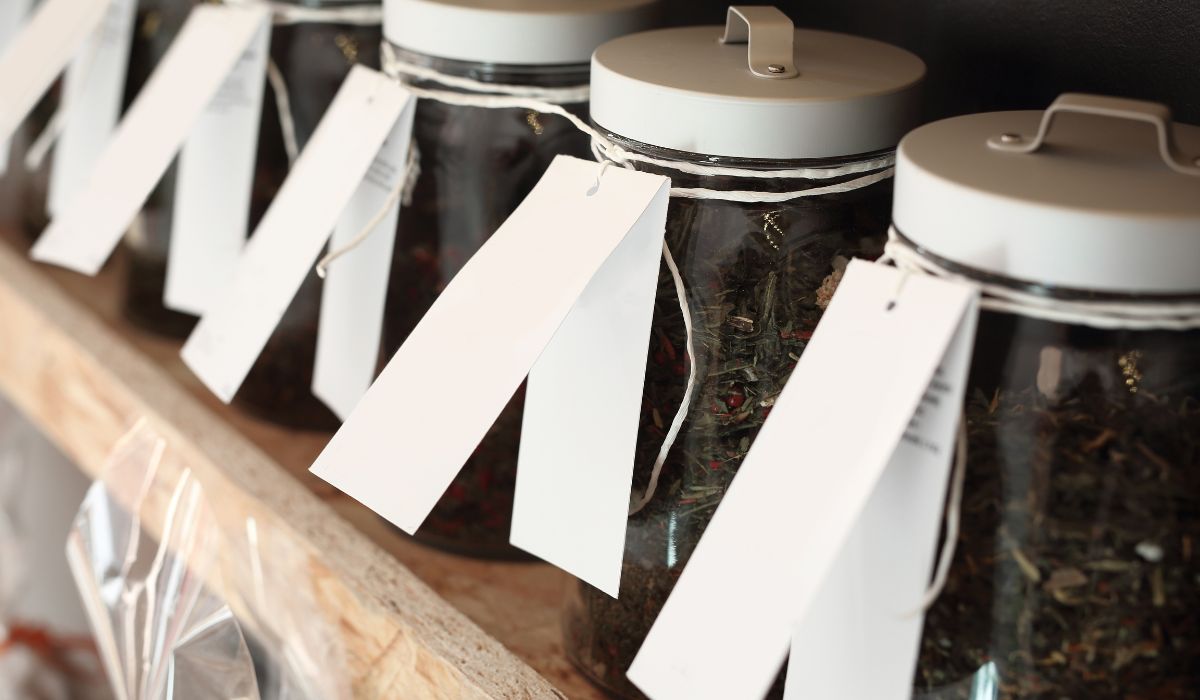
💡Fair Trade certification supports sustainable farming practices and invests in community development, ensuring that tea farmers can build a better future for themselves and their families.
Conclusion: Embracing the World of Green Tea
As we wrap up our exploration of the best loose leaf green tea, we recognize the depth and diversity this ancient beverage offers. From its health benefits and cultural significance to the artistry behind each variety, green tea stands out as a beverage of choice for many around the globe. Among the finest teas is organic Uji matcha, a product that embodies the pinnacle of green tea quality and tradition.
Organic Uji Matcha: Grown in the revered tea fields of Uji, Japan, this matcha is not just a tea; it's a cultural heritage. The meticulous care in cultivation and processing, adhering to strict organic standards, ensures that each cup offers the rich, smooth, and umami-packed flavor that matcha is famous for. By choosing organic Uji matcha, you're indulging in a premium tea experience and supporting sustainable agriculture and ethical farming practices.
Whether you're a seasoned tea enthusiast or a newcomer eager to explore, integrating organic Uji matcha into your routine is a step toward a healthier, more mindful lifestyle. Its versatility, whether traditionally whisked in a bowl or as an ingredient in lattes and smoothies, makes it a perfect ambassador for green tea.
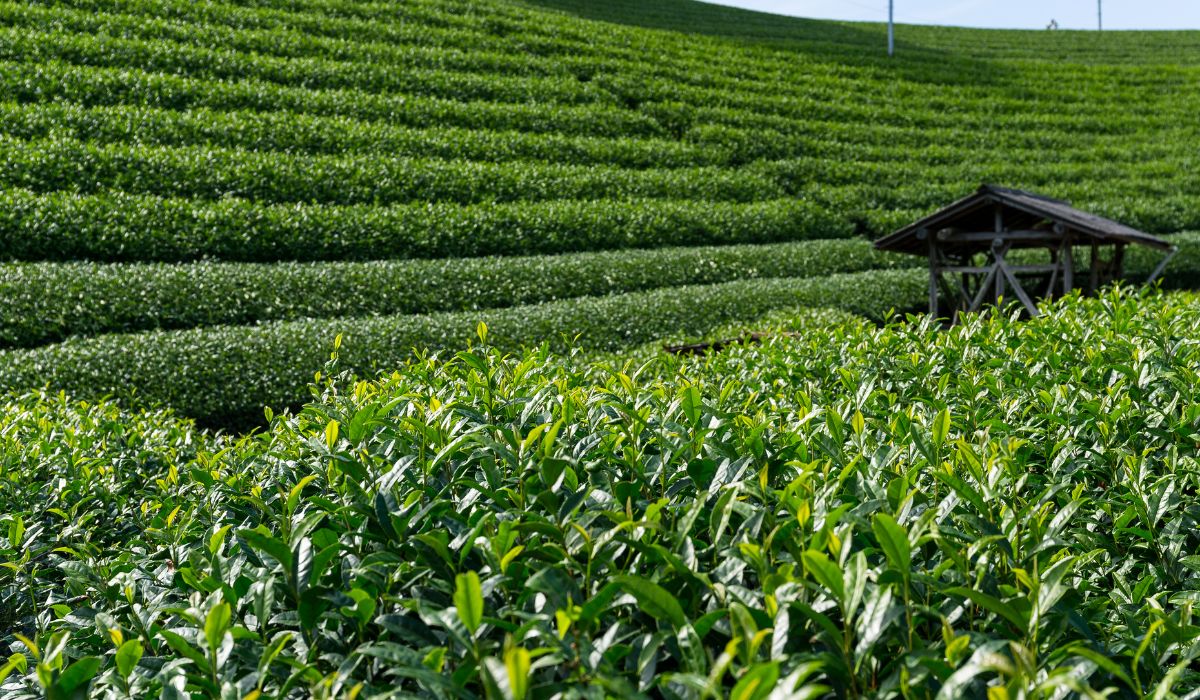
💡Uji, a region in Kyoto, Japan, is renowned for producing the highest quality matcha thanks to its optimal climate, rich soil, and centuries-old tea cultivation techniques.
Caffeine in Matcha Green Tea: What You Need to Know
Explore the fascinating world of matcha green tea through this informative article. Discover its unique history, shading process, and health advantages. Get a comprehensive understanding of matcha's caffeine levels and...

Introduction
Matcha green tea is a popular and healthy beverage consumed in Japan and other parts of the world for centuries. Green tea leaves are ground into a fine powder and whisked into hot water to create a frothy, refreshing drink. Matcha is known for its unique flavor, vibrant green color, and numerous health benefits, including its high concentration of antioxidants and amino acids.
Understanding Matcha and Its Roots
The Camellia Sinensis Plant
The tea plant, Camellia sinensis, is an evergreen shrub native to China and Southeast Asia. It is the source of all true teas, including green, black, and white tea. The tea plant is grown in various climates and soil conditions. Yet, it thrives in moderate temperatures, high humidity, and well-drained soil.

Types of Green Tea: An Overview
Green tea is known for its health benefits and unique taste. There are various types of green tea, including sencha, gyokuro, hojicha, and, of course, matcha, each with unique characteristics.
- Sencha is a delicate and refreshing green tea made from high-quality tea leaves that are steamed, rolled, and dried to produce a smooth and mild taste.
- Gyokuro is a high-quality Japanese green tea grown in the shade, resulting in a sweet and less bitter taste than other green teas.
- Hojicha is a Japanese green tea roasted over charcoal, giving it a nutty and smoky flavor.
- Matcha is made from finely ground green tea leaves and is known for its vibrant green color, earthy flavor, and numerous health benefits.
All types of green tea are packed with antioxidants and are considered a healthy beverage choice.
Shading vs. sun exposure on the tea plants
Regular green tea, such as sencha and bancha, is typically grown under full sunlight. The plants are commonly cultivated in vast fields and exposed to ample sunlight, allowing the tea leaves to develop and produce a robust flavor.
However, matcha and gyokuro are different. Tea plants are shaded up to one month before harvest to produce these green tea varieties. This shading process, known as "tana," involves covering the tea plants with a cloth or netting, which reduces the amount of sunlight that reaches the leaves.
The restriction of sunlight exposure causes the tea leaves to grow bigger and thinner. It also changes the flavor and texture of the tea leaves, making them sweeter, softer, and more delicate. Shading also increases the levels of chlorophyll and amino acids in the leaves, resulting in a brighter green color and a more intense umami flavor.

Green Tea Powder vs Matcha
Green tea powder and matcha are often confused, but there is a key difference between the two. Green tea powder is produced by grinding green tea leaves into fine powder. Green tea is grown under direct sunlight for the entire duration of its cultivation. The sunlight exposure enables the tea leaves to increase their catechins, or antioxidants, which gives green tea its distinctly bitter flavor.
Matcha, a form of green tea powder, is made from tea leaves shaded from sunlight for several weeks before harvest. Restricting sunlight increases the level of l-theanine amino acid in the tea leaves, giving matcha its distinctive umami fragrance and flavor. It also reduces the bitterness and raises the levels of chlorophyll, among other beneficial compounds.
These unique production methods give matcha its characteristic green color and richer flavor when compared to green tea powder. Additionally, matcha is traditionally used in Japanese tea ceremonies, while green tea powder is more commonly utilized in cooking and baking.
Tea Bags vs. Green Tea Powder
Tea bags and green tea powder are two popular ways to enjoy green tea. Tea bags are convenient and easy to use but often contain lower-quality tea leaves that have been ground into small fragments. Green tea powder is created by grinding whole tea leaves into a fine powder, resulting in a more complex flavor and higher concentration of beneficial compounds.
Benefits of Matcha and Green Tea

Heart Health and Powerful Antioxidants in Matcha
Matcha contains high concentrations of powerful antioxidants that are beneficial for heart health. These antioxidants, including epigallocatechin gallate (EGCG), can help reduce inflammation and lower cholesterol levels, reducing the risk of heart disease.
Additionally, matcha is rich in catechins, which have been shown to improve blood flow and lower blood pressure. Incorporating matcha into your diet makes providing your body with these heart-healthy benefits easy.
Weight Loss and Blood Sugar Levels: The Green Tea Effect
Studies have shown that green tea can positively impact weight management and blood sugar regulation. The active compounds in green tea, particularly catechins, may help to increase metabolism and reduce body fat.
Green tea can also improve insulin sensitivity and reduce glucose absorption, lowering blood sugar levels. These findings suggest that incorporating green tea into a healthy diet and exercise routine supports weight loss and blood sugar control.
Vitamin C and Immune Support in Matcha
Matcha is an excellent source of vitamin C, an important antioxidant that can help boost the immune system. Vitamin C is essential for the production of collagen. This protein is vital for healthy skin, bones, and connective tissues. It also helps boost the body's ability to absorb iron, which is essential for healthy blood cells.

Balancing Caffeine with L-Theanine for Improved Cognitive Function
Matcha is also high in the amino acid L-theanine, which promotes relaxation and reduces stress. This amino acid works in synergy with caffeine to foster a state of calm alertness, which can improve cognitive function and mental clarity. L-theanine also enhances sleep quality and reduces symptoms of anxiety and depression.
Caffeine Content and Its Impact
Caffeine Content of Matcha vs. Regular Green Tea
Matcha is a type of green tea known for its high caffeine content. It contains between 18.9 and 44.4 milligrams of caffeine per gram of matcha powder, higher than most other types of green tea. However, the caffeine in matcha is released more slowly into the bloodstream than the caffeine in coffee or energy drinks, which can lead to a more sustained and balanced energy boost.
Comparing Caffeine Levels: Matcha, Coffee Beans, and Energy Drinks
Matcha contains less caffeine than coffee beans, which have 10.0–12.0 mg of caffeine per gram of beans. However, the caffeine in matcha is more bioavailable than coffee, so the body absorbs it more quickly and efficiently. On the other hand, energy drinks can contain up to 300mg of caffeine per serving, a significantly higher caffeine content than matcha or coffee.

Effects of Caffeine on the Central Nervous System
Caffeine is a central nervous system stimulant that can improve cognitive function, increase alertness, and reduce fatigue. It works by blocking the action of adenosine, a neurotransmitter that promotes sleep and relaxation. However, caffeine can also cause side effects such as nervousness, jitteriness, and insomnia, especially when consumed in large amounts.
Blood Pressure and Caffeine: The Matcha Connection
Caffeine can increase blood pressure in some people, especially those with high blood pressure or cardiovascular disease. However, the effect of caffeine on blood pressure can vary depending on the individual and the amount consumed. Like other green teas, matcha contains compounds that lower blood pressure, which can help counteract the effects of caffeine.
Matcha in Daily Life
Incorporating Matcha into Your Daily Routine for Optimal Health
Incorporating matcha and green tea into your daily routine can have numerous health benefits. Aim to consume at least one cup of green tea or matcha daily to reap the health benefits, but be mindful of caffeine intake, especially if you are sensitive to it. While green tea and matcha are healthy beverages, they should not be relied on as a cure-all for health issues. A balanced diet, regular exercise, and healthy lifestyle choices remain the foundation of good health.
Lower Grades of Matcha: Understanding the Differences
Matcha is available in different grades, each with its unique flavor, texture, and price point. The highest grades of matcha are made from the youngest and most delicate tea leaves, harvested from shaded tea crops, and ground into a fine powder. Lower grades of matcha are made from older and coarser tea leaves, which are less expensive but less flavorful and nutritious.
Matcha vs. Coffee

Is Matcha Better than Coffee for Anxiety?
Matcha's high concentration of L-theanine has been shown to have a calming effect on both body and mind. This amino acid works in synergy with caffeine to promote a state of calm alertness, which can help reduce anxiety and stress symptoms. Coffee, on the other hand, can increase anxiety and nervousness in some people, especially when consumed in large amounts.
Matcha vs. Coffee: A Caffeine Showdown
Matcha contains less caffeine than coffee, but it also contains other compounds that can enhance the effects of caffeine and promote more sustained and balanced energy levels. The caffeine in coffee is absorbed more quickly and efficiently by the body, leading to a more intense caffeine boost followed by a caffeine crash.
FAQs:
1. Is Matcha Tea High in Caffeine?
Yes, matcha's caffeine content is high. It contains between 18.9 and 44.4 mg caffeine per gram of tea, higher than most other types of green tea.
2. Is Matcha Stronger than Coffee?
No, matcha is not stronger than coffee in terms of caffeine content. However, the caffeine in matcha is more bioavailable than coffee, so the body absorbs it more quickly and efficiently.
3. How Much Caffeine is in Green Tea vs Coffee?
Green tea contains less caffeine than coffee, but it also contains other compounds that can enhance the effects of caffeine and promote a more sustained and balanced energy boost.
4. Is Matcha Better than Coffee for Anxiety?
Matcha's high concentration of L-theanine has a calming effect on the body and mind. Coffee, on the other hand, can increase anxiety and nervousness in some people, especially when consumed in large amounts.
5. How Much Matcha is Safe Per Day?
Most experts recommend consuming no more than 2-3 cups of matcha daily, or approximately 200-300mg of caffeine.
6. Will Matcha Keep Me Awake?
Like other sources of caffeine, matcha can help promote alertness and reduce fatigue. However, consuming too much caffeine can also cause side effects such as nervousness, jitteriness, and insomnia. Consuming matcha in moderation and being mindful of your caffeine intake is essential.

Conclusion
Matcha green tea is a healthy and delicious beverage enjoyed for centuries. It is rich in antioxidants, catechins, and other beneficial compounds that can promote health and wellness.
Matcha also contains caffeine, which can help to promote alertness and reduce fatigue. Consuming matcha in moderation is important, and being mindful of caffeine intake is necessary. With its unique flavor, vibrant green color, and numerous health benefits, matcha is a beverage everyone should try at least once.
Best Japanese Green Tea: Matcha, Sencha, and Beyond
Explore the captivating world of Japanese green tea, where ancient customs blend with health and taste. Discover the distinct types like Matcha, Sencha, and others, along with their exclusive brewing...

Introduction to Japanese Green Tea
Japanese green tea, more than just a beverage, is a quintessential part of Japanese culture. Revered for its rich history spanning centuries and its integral role in famous Japanese tea ceremonies, green tea in Japan symbolizes hospitality, mindfulness, and art.
Health Benefits of Japanese Green Tea
Rich in Antioxidants: Japanese green tea is a powerhouse of antioxidants, particularly catechins, which combat free radicals and support overall health.
Boosts Brain Function: Green tea contains L-theanine, which is linked to improved cognitive function. This amino acid promotes relaxation and alertness.
Weight Loss Ally: Green tea accelerates metabolism, aiding in weight loss and maintenance.
Heart Health: It's known to improve blood flow and lower cholesterol levels.
💡Did you know? The steaming of green tea leaves, the production method used in Japan, helps retain the tea's vibrant green color and rich nutritional profile.
Exploring Varieties: From Tea Bags to Loose Leaf
Regarding tea, two standard methods are generally used for its preparation - Tea Bags and Loose Leaf Tea.
- Tea Bags are perfect for those seeking convenience and quick preparation. They are easy to use and are found in almost any supermarket.
- On the other hand, Loose Leaf Tea offers a more authentic experience, allowing the full flavor and aroma to unfold. Loose Leaf Tea is usually of higher quality and comes in various flavors. While preparing requires more time and effort, the result is worth it.
Ultimately, the choice between Tea Bags and Loose Leaf Tea comes down to personal preference and the occasion.
Matcha Powder: The Heart of Japanese Tea
Matcha is the finely ground powder of specially grown and processed green tea leaves, and it is considered the pinnacle of Japanese green tea. It is famous for its vibrant color, rich taste, and versatility in traditional ceremonies and modern culinary uses.
In the traditional Japanese tea ceremony, matcha is considered a symbol of hospitality and skill. On the other hand, in modern culinary uses, matcha adds a unique flavor to various dishes ranging from lattes to desserts.
Matcha is a superfood loaded with antioxidants that help to boost metabolism and enhance overall health.
Camellia Sinensis: The Source
The tea plant Camellia Sinensis produces all kinds of green tea, including those from Japan. Due to its specific cultivation and processing techniques, it leads to variations in flavor, aroma, and color.
The plant is used for tea production and is highly valued for its medicinal properties. Camellia Sinensis has played a significant role in human culture for centuries, making it an interesting and fascinating plant.
Gyokuro Tea: A Premium Experience
If you're a fan of high-quality teas, give Gyokuro a try. It's a premium Japanese green tea that has a unique flavor profile. One of the things that makes Gyokuro stand out from other green teas is its exceptional umami flavor. This is accomplished by shading tea plants for several weeks before harvesting the leaves.
This process enhances the concentration of L-theanine and caffeine in the tea leaves, resulting in an incredibly satisfying sweet and mellow taste. Gyokuro is a tea that should be savored slowly, allowing you to appreciate its complex and nuanced flavor fully. If you're looking for a truly premium tea experience, then Gyokuro is worth trying.
💡Gyokuro means 'jewel dew' in Japanese. This name reflects its esteemed status and the dew-like appearance of its infusion.
Bancha Tea: The Everyday Japanese Green Tea
Bancha tea, also known as "common tea" or "coarse tea," is a Japanese green tea harvested from the second flush of tea leaves. It is known for its smooth and mellow flavor, with a slightly nutty and earthy undertone.
Bancha tea is also low in caffeine content, making it an excellent choice for those who want to enjoy a cup of tea without the jitters. Due to its mild flavor, it is often consumed as an everyday tea in Japan. It is a popular choice among tea enthusiasts all over the world. So, if you have yet to try Bancha tea, it's worth exploring!
Organic Tea: A Pure and Natural Delight
Organic Japanese green tea is a true delight for tea lovers who appreciate their brews' purity and natural taste. Unlike conventional teas, organic tea is cultivated without synthetic fertilizers or pesticides, making it a healthier and safer choice for you and the environment.
Not only does organic tea offer a great taste, but it is also a commitment to environmental sustainability and health. By choosing organic tea, you support farmers who use eco-friendly farming practices that help preserve the delicate balance of nature.
So, organic tea is the way to go whether you're looking for a refreshing cup of tea or a healthier beverage choice. Enjoy organic Japanese green tea's pure and natural taste and take a step towards a healthier and more sustainable future.
High-quality tea from the Kagoshima prefecture
Try high-quality Japanese green tea from the Kagoshima Prefecture if you love tea. This tea is renowned for its exceptional aroma, flavor, and color, which result from various factors such as the first harvest, the region where it is grown, and the meticulous processing methods used by skilled artisans.
Thanks to its favorable climate conditions and fertile soil, Kagoshima produces the highest quality tea leaves. The region is located on the southern tip of Kyushu Island. It is renowned for its exceptional green tea, which is famous for its delicate sweetness and rich umami taste.
The processing of tea leaves is an art in Kagoshima Prefecture. The artisans use traditional methods and pay close attention to every detail to ensure that the tea's flavor and aroma are not compromised. The tea is carefully harvested, steamed, and dried to preserve its freshness and quality.
So, to experience Japanese green tea's rich, authentic taste, get your hands on high-quality tea from the Kagoshima Prefecture.
Chinese Green Tea vs. Japanese Green Tea
Green tea is an incredibly popular drink worldwide, and two of the most famous varieties are Chinese and Japanese. Although both types of tea come from the same Camellia sinensis plant, they differ in processing methods, which leads to unique flavors and aromas.
Chinese green tea is usually pan-fired, which helps stop oxidation and preserve natural flavors. This method gives the tea a nutty, roasted flavor and a slightly smoky aroma. Some famous Chinese green teas include Dragonwell (Longjing) and Gunpowder tea (Zhu Cha).
In contrast, Japanese green tea is steamed, allowing the leaves to retain more natural color and flavor. This results in a fresher and more grassy taste with a vegetal aroma. Sencha and Matcha are two of the most popular types of Japanese green tea.
So, depending on your taste preferences, you can choose between these two types of green tea and enjoy their unique flavors and benefits.
Regular Green Tea vs. Shade-Grown Tea
One of the main differences between green tea varieties is whether they are grown in full sunlight or under shade. Regular green tea is cultivated in full sunlight, which causes the tea leaves to produce more tannins, giving it a more astringent, bitter taste.
On the other hand, shade-grown teas like Gyokuro and Matcha are shielded from direct sunlight, which increases their chlorophyll content and gives them a sweeter, more umami-rich flavor. In addition to the taste, shade-grown teas are also known for their vibrant green color and their higher levels of antioxidants and other beneficial compounds.
So, if you're looking for a more mellow and flavorful cup of tea, try shade-grown green teas.
Black Tea: A Different Kind of Brew
When it comes to tea, most people think of green tea as the quintessential Japanese brew. However, another type of tea gaining popularity in Japan is black tea, also known as 'Wakocha.'
Wakocha is a fully oxidized tea with a unique flavor profile compared to other Japanese teas. It's stronger in taste and has a higher caffeine content, making it an excellent choice for those who want a little more kick in their cup of tea.
What's interesting about Wakocha is that it's not a traditional Japanese tea. The British introduced it in the late 19th century, and it has since become a popular alternative to green tea. While it may not be as well-known as green tea, Wakocha is worth a try for anyone who enjoys a bold, flavorful tea.
💡Wakocha is a relatively new addition to Japan's tea repertoire, gaining popularity for its mellow and sweet flavor, distinct from traditional black teas.
Green Tea for Weight Loss
Japanese green tea, particularly varieties like Sencha, is a widely consumed and healthy beverage highly regarded for its numerous health benefits. One of the most notable advantages of Japanese green tea is its ability to assist in weight loss. This is because of the presence of catechins, an antioxidant in green tea.
Catechins are known to speed up metabolism and increase the body's rate of burning fat. This can lead to a reduction in body weight and body fat percentage. Japanese green tea is also known to contain caffeine, which can further boost metabolism and increase energy levels, making it a great alternative to sugary and calorie-laden drinks.
Incorporating Japanese green tea into your daily routine can be an effective and healthy way to aid in weight loss and improve overall health.
Sencha Tea: The Popular Choice
Sencha green tea is a trendy and widely consumed tea in Japan. Renowned for its perfect balance of sweetness and astringency, Sencha tea offers a delightful flavor profile that can be enjoyed both hot and cold.
Sencha tea contains high levels of antioxidants, making it an excellent choice for a healthy and rejuvenating beverage for tea lovers. Its unique flavor and aroma make it a perfect complement to various foods, making it an ideal drink to have with meals.
The popularity of Sencha tea can be attributed to its rich history and cultural significance in Japan. The tea is made from the uppermost leaves of the Camellia sinensis plant. It is typically steamed and rolled to preserve its delicate flavor and aroma.
Overall, Sencha tea is an excellent choice for those looking for a healthy, flavorful, and culturally significant tea that can be enjoyed anytime.
Shizuoka Prefecture: The Heartland of Japanese Tea
Shizuoka Prefecture in central Japan is famous for producing high-quality tea. The region's ideal climate, fertile soil, and abundant rainfall create perfect conditions for growing tea, resulting in some of Japan's most flavorful and aromatic teas. Shizuoka is particularly famous for producing sencha, a refreshing and grassy-flavored green tea with a hint of sweetness.
The region is also known for its premium matcha, a fine powder made by grinding shade-grown tea leaves, resulting in a rich and creamy flavor. If you're a tea enthusiast looking to experience the best Japanese tea culture, visiting Shizuoka is a must.
Brain Function and Green Tea
Did you know that regular consumption of Japanese green tea, particularly Matcha, is linked to enhanced brain function? The combination of caffeine and L-theanine found in Matcha green tea has been shown to improve cognitive clarity, focus, reaction time, and memory.
Caffeine stimulates the central nervous system, which increases alertness and improves cognitive performance. At the same time, L-theanine promotes relaxation and reduces anxiety. This unique combination of natural compounds makes Matcha green tea a delicious and healthy way to boost your brain function and productivity.
So, next time you need a mental pick-me-up, why not try a cup of Matcha green tea and see the difference it can make for your cognitive performance?
Mass-produced teas vs. Artisanal Japanese Green Tea
If you are a tea enthusiast, you must have tried different types of tea. But have you ever tried artisanal Japanese green tea? It is considered one of the best types of tea available in the market. Unlike mass-produced teas, which are often tasteless and lack nutritional benefits, artisanal teas are meticulously crafted by expert tea masters, offering a richer, more complex profile that genuinely reflects the terroir and the tea master's expertise.
Artisanal Japanese green tea is not just a beverage but an experience that indulges all senses. These teas' aroma, taste, and texture are unparalleled and leave a lasting impression on the palate. They are not only delicious but also packed with numerous health benefits. They are rich in antioxidants, vitamins, and minerals that help boost immunity, reduce stress, and promote overall well-being.
From delicate sencha to full-bodied matcha, artisanal Japanese green teas come in various flavors and textures, catering to different tastes and preferences. Sencha, for instance, is a light and refreshing tea perfect for daytime drinking. At the same time, matcha is a full-bodied tea known for its bold flavor and creamy texture. So, whether you are looking for a subtle or bold flavor, there is a tea out there to suit every taste and occasion.
Suppose you are a tea lover who appreciates the subtle nuances of a well-crafted brew or just looking for a healthier, more delicious way to stay hydrated. In that case, artisanal Japanese green teas are an excellent choice. So, why settle for anything less than the best? Try artisanal Japanese green tea today and embark on a journey of indulgence and wellness.
Oolong Tea: A Different Japanese Brew
You might be familiar with popular Japanese teas like green tea and matcha if you're a tea lover. However, there's another type of tea that's less commonly known in Japan - Oolong tea. Although it originated in China, Oolong tea has gained popularity worldwide. Japanese Oolong teas are a unique variation of this tea type.
Japanese Oolong tea stands out because of its lighter, more floral profile compared to its Chinese counterpart. This is because it uses a different process, partially oxidizing the tea leaves and bridging the gap between green and black teas. So, if you're looking to try something different, why not try Japanese Oolong tea?
💡Japanese Oolong tea, though less prevalent, is gaining recognition for its delicate flavors and health benefits, similar to green tea.
Exploring the Nuances of Japanese Green Tea
Genmaicha, or "popcorn tea," is a Japanese green tea blended with roasted brown rice. This unique combination of ingredients offers a comforting, nutty flavor that is quite distinct from other types of tea.
Due to its lower caffeine content, it is popular for those who want to enjoy a soothing cup of tea without the jitters that can come with higher caffeine levels. Genmaicha is a delicious and satisfying tea that is perfect for any occasion.
Tea Plants: Diverse Cultivars, Diverse Flavors
Japan is known for its green tea, which comes in various flavors and aromas thanks to the different cultivars used in its production. Samidori, Saemidori, Okumidori, Gokou, Yabukita, Asahi, and Kanayamidori are among the most popular cultivars. Each cultivar has unique characteristics that contribute to the overall taste of the tea.
For example, Yabukita is known for its vegetal notes, while Asahi is prized for its intense umami flavor. These varieties are carefully cultivated and processed to create the perfect cup of tea, ensuring every sip is a delight to the senses.
High-Grade Matcha: A Luxurious Experience
Ceremonial grade matcha is the finest quality matcha available, made from the youngest, most delicate tea leaves. It is highly valued for its vibrant color, delicate flavor, and traditional use in Japanese tea ceremonies. Consuming ceremonial-grade matcha is considered a luxurious experience and perfect for special occasions.
Ceremonial grade matcha can be enjoyed as either usucha or koicha (thin or thick tea) and is whisked with hot water using a bamboo chasen. It has an intense umami flavor and minimal astringency, making it a delightful and healthy drink for tea enthusiasts.
Japanese Culture and Green Tea
Japanese green tea is deeply rooted in Japanese culture, symbolizing hospitality, peace, and simplicity. It is considered a cultural heritage that offers a journey of discovery.
It promotes wellness, mental clarity, and a sense of calm thanks to its rich antioxidants, vitamins, and amino acids. Japanese green tea is not just a beverage but a profound spiritual and aesthetic experience.
Flush Sencha: The First Pick
Harvested in spring, the first flush of Sencha is highly valued for its fresh and vibrant flavor. It is considered the highest quality and serves as the perfect introduction to Japanese green tea.
The first flush contains the highest levels of antioxidants and beneficial compounds, as the tea leaves have not been picked since the previous year's harvest season. After the first flush, the tea plants grow new tea leaves, which are harvested again within one month. This process happens again for the third flush. Some tea farms also harvest in autumn and winter.
Tea enthusiasts must understand the harvests to make informed decisions while selecting their tea. The first spring flush, known as ichibancha in Japanese, is the most concentrated and flavorful tea. Subsequent harvests are depleted in nutritional composition and flavor. Hence, one should always opt for the first spring harvest wherever possible.
The Significance of the Japanese Tea Ceremony
The Japanese tea ceremony is an essential part of Japanese culture. It is more than a mere act of drinking tea. It embodies harmony, respect, purity, and tranquility, reflecting the profound philosophy behind Japanese culture.
The bamboo whisk, or Chasen, is essential in preparing Matcha. It helps create a smooth, lump-free texture and the characteristic frothy top of a well-prepared Matcha.
Buddhist Monks and Green Tea: A Historical Connection
The tradition of green tea in Japan began millennia ago, influenced by Buddhist monks who brought tea seeds from China. Producing high-quality Japanese green tea requires meticulous cultivation, precise processing, and a deep appreciation of tradition. It's a commitment to delivering a superior tea experience.
Cold Water Brewing: A Refreshing Twist
Brewing Japanese green tea with cold water, especially Sencha and Gyokuro, brings out a smoother, sweeter flavor, making it a refreshing alternative to hot brewing. Hot water brewing is the traditional method, ideal for extracting the full range of tastes, especially in teas like Sencha and Bancha.
Finding Your Favorite Japanese Green Tea
Discovering your favorite Japanese green tea is a personal journey. It's about exploring different varieties and brewing methods to find the one that resonates with your palate. Investing in premium Japanese green tea is an investment in quality. It's about experiencing the best flavor, aroma, and health benefits.
Conclusion: Embracing the World of Japanese Green Tea
The world of flavors waiting to be discovered is vast and exciting. We invite you to start your tea journey with Japanese green tea by exploring different varieties, experimenting with brewing techniques, and finding your favorite.
Keep In Touch
Signup for exclusive offers and promotions.










